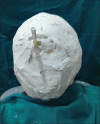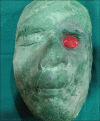Prosthetic rehabilitation of an orbital defect for a patient with hemifacial atrophy
- PMID: 27134435
- PMCID: PMC4832803
- DOI: 10.4103/0972-4052.175716
Prosthetic rehabilitation of an orbital defect for a patient with hemifacial atrophy
Abstract
Removal of an eye may be indicated in cases of congenital abnormality, severe trauma, or disease such as an infection, tumor, or malignancy. The disfigurement associated with a loss of an eye is often accompanied with physical problems, psychological trauma, and a poor quality of life. A prosthetic replacement is the treatment of choice to return the individual to his normal vocation by producing an acceptable and life-like appearance. This article describes prosthetic rehabilitation of a 19-year-old male suffering from facial hemiatrophy with the loss of his left eye due to retinoblastoma when he was 2-year-old using medically graded silicone material. The technique used is simple, cost effective, and easy way for fabrication and rehabilitation of an orbital defect using silicone prosthesis where retention is achieved by a combination of silicone adhesives and tapes, and to a very small extent by bony and soft tissue undercut, hence providing better esthetic and psychological outcome. The acrylic part of the prosthesis was adhered to the socket with the help of a two-way silicon adhesive tape. Since the patient had lost his eye when he was 2-year-old, the development of eye and periorbital tissue on the defect side lead to hemiatrophy; in our approach, we have attempted to build the prosthesis in par with the normal side so that the fullness on the defect side was restored to that of the contralateral side. The fabricated facial prosthesis was durable, esthetic, and had good retention.
Keywords: Adhesives; facial hemiatrophy; orbital prosthesis; retinoblastoma; silicones.
Figures








Similar articles
-
Advancements in Soft-Tissue Prosthetics Part B: The Chemistry of Imitating Life.Front Bioeng Biotechnol. 2020 Apr 23;8:147. doi: 10.3389/fbioe.2020.00147. eCollection 2020. Front Bioeng Biotechnol. 2020. PMID: 32391336 Free PMC article. Review.
-
A Novel Method for the Management of Anophthalmic Socket.Adv Biomed Res. 2017 Jun 12;6:72. doi: 10.4103/abr.abr_247_16. eCollection 2017. Adv Biomed Res. 2017. PMID: 28706880 Free PMC article.
-
A novel method for retention of an orbital prosthesis in a case with continuous maxillary and orbital defect.J Indian Prosthodont Soc. 2010 Jun;10(2):132-6. doi: 10.1007/s13191-010-0025-x. Epub 2010 Dec 8. J Indian Prosthodont Soc. 2010. PMID: 21629458 Free PMC article.
-
Precision in Prosthetics: Two Case Reports on Transformative Rehabilitation With Custom Ocular and Orbital Prostheses.Cureus. 2024 Oct 27;16(10):e72485. doi: 10.7759/cureus.72485. eCollection 2024 Oct. Cureus. 2024. PMID: 39600738 Free PMC article.
-
Combination of skin flap and silicone prosthesis for rehabilitation of a large orbital defect: A case report.Indian J Dent Res. 2018 Nov-Dec;29(6):840-843. doi: 10.4103/ijdr.IJDR_20_17. Indian J Dent Res. 2018. PMID: 30589017
Cited by
-
Advancements in Soft-Tissue Prosthetics Part B: The Chemistry of Imitating Life.Front Bioeng Biotechnol. 2020 Apr 23;8:147. doi: 10.3389/fbioe.2020.00147. eCollection 2020. Front Bioeng Biotechnol. 2020. PMID: 32391336 Free PMC article. Review.
-
Advancements in Soft-Tissue Prosthetics Part A: The Art of Imitating Life.Front Bioeng Biotechnol. 2020 Mar 31;8:121. doi: 10.3389/fbioe.2020.00121. eCollection 2020. Front Bioeng Biotechnol. 2020. PMID: 32300585 Free PMC article. Review.
References
-
- Goel BS, Kumar D. Evaluation of ocular prosthesis. J All India Ophthalmol Soc. 1969;17:266–9. - PubMed
-
- Nath K, Gogi R. “The orbit” (a review) Indian J Ophthalmol. 1976;24:1–14. - PubMed
-
- Abramson DH. Retinoblastoma incidence in the United States. Arch Ophthalmol. 1990;108:1514. - PubMed
-
- Arora RS, Eden TO, Kapoor G. Epidemiology of childhood cancer in India. Indian J Cancer. 2009;46:264–73. - PubMed
-
- Mishra SK, Ramesh C. Reproduction of custom-made eye prosthesis manoeuvre: A case report. J Dent Oral Hyg. 2009;1:59–63.
Publication types
LinkOut - more resources
Full Text Sources
Other Literature Sources
